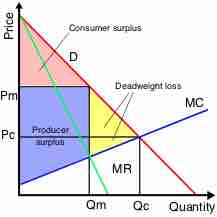Monopolies, unlike perfectly competitive firms, are able to influence the price of a good and are able to make a positive economic profit. While a perfectly competitive firm faces a single market price, represented by a horizontal demand/marginal revenue curve, a monopoly has the market all to itself and faces the downward-sloping market demand curve. An important consequence is worth noticing: typically a monopoly selects a higher price and lesser quantity of output than a price-taking company; again, less is available at a higher price.
Imagine that the market demand for widgets is Q=30-2P. This says that when the price is one, the market will demand 28 widgets; when the price is two, the market will demand 26 widgets; and so on. The monopoly's total revenue is equal to the price of the widget multiplied by the quantity sold: P(30-2P). This can also be rearranged so that it is written in terms of quantity: total revenue equals Q(30-Q)/2.
The firm can produce widgets at a total cost of 2Q2, that is, it can produce one widget for $2, two widgets for $8, three widgets for $18, and so on. We know that all firms maximize profit by setting marginal costs equal to marginal revenue. Finding this point requires taking the derivative of total revenue and total cost in terms of quantity and setting the two derivatives equal to each other. In this case:
Setting these equal to each other:
So the profit maximizing point occurs when Q=3.
At this point, the price of widgets is $13.50, the monopoly's total revenue is $40.50, the total cost is $18, and profit is $22.50. For comparison, it is easy to see that if the firm produced two widgets price would be $14 and profit would be $20; if it produced four widgets price would be $13 and profit would again be $20. Q=3 must be the profit-maximizing output for the monopoly.
Graphically, one can find a monopoly's price, output, and profit by examining the demand, marginal cost, and marginal revenue curves. Again, the firm will always set output at a level at which marginal cost equals marginal revenue, so the quantity is found where these two curves intersect. Price, however, is determined by the demand for the good when that quantity is produced. Because a monopoly's marginal revenue is always below the demand curve, the price will always be above the marginal cost at equilibrium, providing the firm with an economic profit .

Monopoly Pricing
Monopolies create prices that are higher, and output that is lower, than perfectly competitive firms. This causes economic inefficiency.